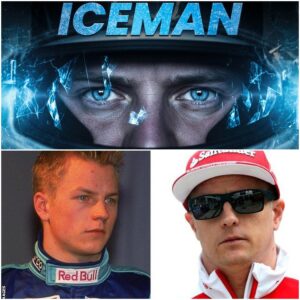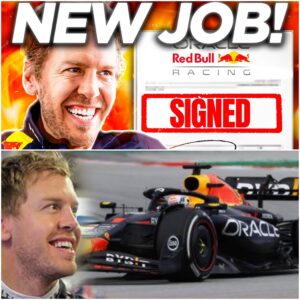The world of Formula 1 thrives on secrecy and spectacle, but rarely does a single image manage to generate such a volatile mix of both. This week, motorsport fans worldwide were brought to a sudden, stunned halt by photos and videos circulating from the Imola Circuit in Italy. The footage was irrefutable: a veteran Formula 1 driver, instantly recognizable by his helmet design, was back behind the wheel of an F1 car. But the car itself was the shockwave. It was a Ferrari. And the driver? None other than the celebrated, recently-departed Red Bull star, Sergio “Checo” Perez.
Perez, who is famously signed to spearhead the newest American powerhouse, Cadillac, for their 2026 debut, was piloting a machine belonging to one of the most historic and fiercest rivals in the sport. The internet exploded with immediate, frantic speculation. Had Perez pulled off the most sensational contract U-turn in modern F1 history? Was this a hint of a last-minute betrayal of the American dream? The real answer, however, is far more strategic, cold-blooded, and brilliant than any headline could convey. It is the story of a pragmatic alliance, a meticulously planned training operation, and the surprising way a brand-new team is using a competitor’s technology as a ‘Trojan Horse’ to gain a crucial edge for the forthcoming revolution of 2026.

The Rulebook Loophole: Cadillac’s Clandestine Alliance
To understand this astonishing scene, one must look deep into the fine print of the Formula 1 rulebook, specifically the regulations governing the Testing of Previous Cars (TPC). These rules are designed to prevent teams from gaining an unfair competitive advantage by testing current technology. They stipulate that teams are only allowed to use cars that are at least two years old for driver practice and crew training, ensuring that resources are not diverted from the development of their current or next-generation machines.
For a legacy team like Ferrari, this is routine. They have a stable of two-year-old challengers ready to be dusted off for training sessions. But for the Cadillac F1 team, which is set to make its momentous entry onto the grid in 2026, the situation is entirely different. A team starting from scratch has no such history, no ‘previous car’ to call upon.
This strategic vacuum led to an agreement with Ferrari—the team that will supply Cadillac’s engine, gearbox, and suspension components for their first three seasons (2026-2028). The partnership allows Cadillac to lease and utilize Ferrari’s 2023 car, the formidable SF-23, to fast-track their operational readiness.
The test itself was a marvel of anonymity. The SF-23 was completely stripped of its famous scarlet livery, painted instead in a plain, functional, all-black coat. There were no visible Ferrari or Cadillac logos. Perez himself wore a similarly blacked-out race suit and helmet, creating an almost unsettlingly anonymous image. It was a clandestine operation in plain sight, demonstrating a level of commitment to procedure over public relations. For two intense days at Imola, the Cadillac F1 team was finally operating on a real racetrack for the very first time, but under the banner of their most crucial partner.
Beyond the Stopwatch: Testing the Human Machine
If fans were expecting performance fireworks and headline-grabbing lap records from Perez, they were looking in the wrong place. The test was never intended to push the old SF-23 to its limit; it was focused almost entirely on the people and the procedures that govern a race weekend.
As Cadillac’s Team Principal, Graeme Loen, clarified, the months leading up to this moment have been spent exclusively in the simulation chamber, practicing on virtual setups at their base. The Imola session was the first chance to test the team’s operational rhythm in a high-pressure, live environment.
The pit lane garage was a fascinating blend of old and new. Around 20 core Cadillac staff members worked side-by-side with approximately 30 experienced Ferrari personnel, who specialize in running the Italian team’s established testing program. This unprecedented collaboration functions as a high-speed mentorship program, allowing the American newcomers to absorb decades of knowledge and operational best practice from one of the most successful teams in motorsport history.
“What we want to test is the people,” stated Loen. “So we want to get people used to working together, doing rapid turnarounds that are needed in quali, doing staff procedures.”
For the mechanics and engineers, this meant performing tasks like lightning-fast pit stops, carrying out complex car setup changes under duress, and conducting data analysis immediately after a run—all against the unrelenting ticking clock of a real track session. This practice is priceless for fostering the deep-seated chemistry and razor-sharp efficiency needed to survive, let alone compete, in the cutthroat world of Formula 1. They are building a crew, not just a car.

Checo’s Resurrection: A Year Off and a New Beginning
The Imola test was equally vital for Sergio Perez’s own personal and professional journey. The 35-year-old had concluded a four-year stint with Red Bull at the end of the 2024 season, stepping away from top-tier motorsport for a planned year-long sabbatical in 2025. This was his first significant break from racing in nearly two decades, and the question of physical readiness after such a hiatus is always a concern for a driver.
Perez used the two days to effectively conduct a grueling self-assessment. He was seeking to recalibrate his mind and body to the brutal G-forces and lightning-quick demands of a modern F1 car. “On the physical side, I want to see how much I’ve lost, where I need to work on,” Perez explained before the session. “It will give me a very good guide for the winter to be able to focus on that stuff.”
In terms of raw data, the driver completed a monumental 99 laps—equivalent to about 457 km of driving—showcasing his immediate fitness. While his best reported lap time was 1 minute 18.20 seconds, a figure significantly slower than the 2025 pole position time of 1 minute 14.070 seconds, any comparison is meaningless. The conditions were different, the car was two years old, and the focus was entirely on executing the team’s procedural mandate, not chasing ultimate performance.
Crucially, the test served a second, more profound purpose: it was Perez’s first opportunity to build a working, human relationship with his new team. He spent precious time in dialogue with Cadillac’s engineers and mechanics, establishing their communication styles, understanding their technical vocabulary, and beginning the essential process of forging mutual trust. This early integration is the bedrock of a successful F1 partnership, ensuring that driver and crew are in complete synergy when the lights go out in 2026.
Cadillac’s Grand Vision and Experienced Hand
The significance of the Imola test is amplified by the sheer scale of Cadillac’s ambition. Their entry in 2026 coincides with a paradigm shift in the sport: sweeping new technical regulations governing both engines and aerodynamics. This regulatory reset effectively shrinks the performance gap, forcing every team, from Mercedes to the newly formed Cadillac, to start from a far more level playing field.
The team’s long-term planning is nothing short of meticulous. While they rely on Ferrari power units, gearboxes, and suspension for the 2026-2028 seasons—a pragmatic approach to getting on the grid quickly—their parent company, General Motors, has committed to building its own bespoke Formula 1 engine for the 2029 season. This signals a deep, sustained commitment to becoming a genuine constructor, not merely a customer team.
Furthermore, Cadillac’s choice of driver pairing is arguably one of the most experienced on the grid. Alongside Perez, they have secured the services of Valtteri Bottas, who will join the team officially after his reserve driver commitments with Mercedes conclude at the end of the year. The pairing boasts a staggering combined total of over 500 Grand Prix starts. This wealth of practical experience is exactly what a nascent team needs. Perez, in particular, with his six career wins and four years spent within the championship-winning Red Bull operation, possesses the institutional knowledge of what a gold-standard, winning F1 team looks like. He can guide Cadillac in establishing their processes, culture, and high standards from the very foundational stage.

The Two Pillars of Success
For Graeme Loen, the measure of success in their debut season is clear and focused. In a recent appearance, he outlined the two core pillars that will define Cadillac’s performance in 2026:
Earning the Competition’s Respect: Loen understands that respect in F1 is not given; it is earned through performance and professionalism. If the top teams respect Cadillac, it will be a true reflection of the quality of the team’s work.
Flawless Execution: The team principal is demanding that the Cadillac team “execute everything that we do to the absolute maximum,” stressing the importance of avoiding mistakes and ensuring that no performance is “left on the table.”
This philosophy underscores that Cadillac is not simply looking to fill a spot on the grid; they are coming to compete at the highest possible level from their very first race.
The Imola test, in its blacked-out, secret operational mode, was the true starting gun for this enormous undertaking. It was a baptism by fire for the crew and a crucial physical and mental reset for their star driver. The next major milestone comes in January 2026 with the first official preseason test of the new-generation cars in Barcelona. Only then, when the American challenger unveils its true colours and its GM-backed engineering, will the world get a true measure of just how well the Trojan Horse strategy has paid off. The American dream in Formula 1 is now officially underway.





